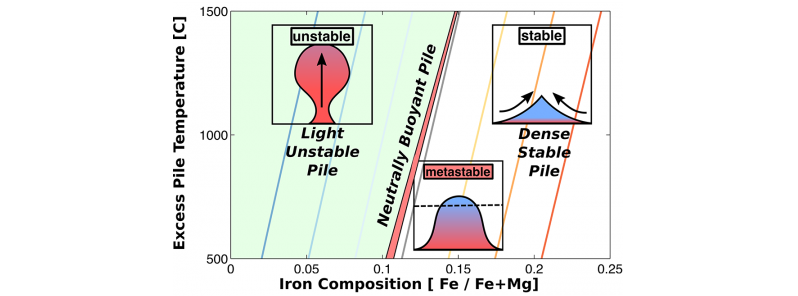New research indicates different composition of Earth’s mantle

Seismic observations of our planet's interior have revealed three distinct structures, marking the boundary between its metallic core and silicate mantle. The structures include remnants of subducted plates from the Earth's surface, ultralow velocity zones rich in iron and large dense provinces of unknown composition and mineralogy. New evidence has emerged showing the origin of these features, California Institute of Technology (Caltech) announced on December 12, 2015.
The layer in question is 2 900 km (1 802 miles) deep and its composition is highly important for understanding the evolution and dynamics of our Earth. A team of scientists has conducted a research which suggests that bridgmanite, the most common mineral on our planet, might occupy 20% of the boundary. Results of the research could explain previous seismic observations and geodynamical modeling results.
"We have discovered that bridgmanite, the most abundant mineral on our planet, is a reasonable candidate for the material that makes up these dense provinces that occupy about 20 percent of the core-mantle boundary surface, and rise up to a depth of about 1 500 km (932 miles) Integrated by volume that's about the size of our moon!. This finding represents a breakthrough because although bridgmanite is the earth's most abundant mineral, we only recently have had the ability to precisely measure samples of it in an environment similar to what we think the materials are experiencing inside the earth," Jennifer Jackson, a professor of mineral physics at Caltech explained.

The illustration showing a bridgmanite sample that is being laser-heated between two diamond anvils. This set-up allows researchers to measure a sample at compressions over 1 million times the earth's atmospheric pressure, while being heated to thousands of degrees Celsius. Image credit: Aaron Wolf and Jennifer Jackson, Caltech
The study has been conducted by taking precise X-ray measurements, with two different beamlines at the Advanced Photon Source of Argonne National Laboratory in Illinois, of synthetic bridgmanite samples compressed by diamond anvil cells to over 1 million times the earth's atmospheric pressure and heated to thousands of degrees. Gathered data has allowed the scientists to compare the results to seismic observations of the core-mantle boundary.
"With these new measurements of bridgmanite at deep mantle conditions, we show that these provinces are very likely to be dense and iron-rich, helping them to remain stable over geologic time," said Aaron Wolf, a researcher from Argonne National Laboratory.
Researchers have also measured the behavior of iron in the crystal structure of bridgmanite, by using a Mössbauer spectroscopy technique. Results showed the iron-bearing bridgmanite is stable in conditions of extreme temperatures over 2 000 °C (3 632 °F) and pressures up to 130 GPa.

This schematic shows different scenarios of bridgmanite provinces that Jennifer Jackson and colleagues explored in their research. Their results found that the scenario at right aligns most closely with geophysical constraints of the lower mantle. Image credit: Aaron Wolf and Jennifer Jackson, Caltech
"This is the first study to combine high-accuracy density and stiffness measurements with Mössbauer spectroscopy, allowing us to pinpoint iron's behavior within bridgmanite. Our results also show that these provinces cannot possibly contain a large complement of radiogenic elements, placing strong constraints on their origin. If present, these radiogenic elements would have rapidly heated and destabilized the piles, contradicting many previous simulations that indicate that they are likely hundreds of millions of years old," explained Wolf.
According to the newest results, it seems the rest of the lower mantle is not entirely composed of bridgmanite, as previously thought, and other phases, or minerals, need to be present as well. "Until we made these measurements, the thermal properties were not known with enough precision and accuracy to uniquely constrain the mineralogy," Jackson explained.
"There is still a lot of work to be done, such as identifying the dynamics of subducting slabs, which we believe plays a role in providing an external force to shape these large bridgmanite provinces. We know that the earth did not start out this way. The provinces had to evolve within the global system, and we think these findings may help large-scale geodynamic modeling that involves tectonic plate reconstructions."
Reference:
- "The thermal equation of state of (Mg, Fe)SiO3 bridgmanite (perovskite) and implications for lower mantle structures" – Aaron S. Wolf, Jennifer M. Jackson, Przemeslaw Dera, Vitali B. Prakapenka – Journal of Geophysical Research Solid Earth (2015) – DOI: 10.1002/2015JB012108
Featured image: This schematic shows different scenarios of bridgmanite provinces that Jennifer Jackson and colleagues explored in their research. Their results found that the scenario at right aligns most closely with geophysical constraints of the lower mantle. Credit: Aaron Wolf and Jennifer Jackson, Caltech

Commenting rules and guidelines
We value the thoughts and opinions of our readers and welcome healthy discussions on our website. In order to maintain a respectful and positive community, we ask that all commenters follow these rules.